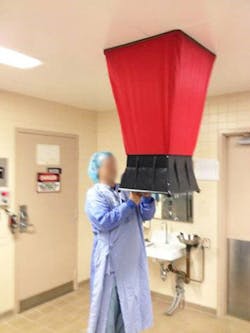Airflow tissue trick, double peel pouching technique
Q
I am new to the department, and I recently saw my manager take a tissue up to a vent. Can you explain why they were doing this?
A
Before calling the Facilities department, many seasoned managers employ the use of this simple tissue trick to test/check air flow. Putting a piece of tissue paper up by the vent indicates whether the vent type is sucking air in or blowing air out. This knowledge ensures the correct pressure and air flow are in those sections of your department.
- Traffic flow
- Physical space (must have):
- One-way flow instruments: dirty to clean.
- Staff: clean to dirty.
- Restricted access.
- Limited entry and movement throughout space.
- Physical barriers to prevent reverse flow and entry should be installed whenever possible.
- The assembly or prep/pack area is a designated clean. Therefore, meticulous care must be taken to maintain that cleanliness.
Airflow in the clean area should always be “positive” in relation to a) the outside hallways, b) decontamination area, c) break rooms and other adjacent areas except for the Sterile Storage area. The purpose of positive airflow is to ensure when doors open to the assembly area, air flows outward instead of into the work area. Positive airflow also reduces the risk of airborne bacteria being introduced into the area.
Q
I work at two different facilities—one has double peel pouch, the other does not. Can you explain why?
A
First, double pouching refers to a technique where an item is placed in one pouch, sealed, then packaged within another larger pouch. This practice should not be performed without written instructions from the peel pouch manufacturer stating that this practice has been validated for the practice of double pouching. Thus, my answer is, “It depends,” on the type of peel pouch being used and what is stated in the instructions for use (IFU) concerning double pouching.
Here are some tips to consider for double pouching.
Things you can do:
- Increase the durability or sterility maintenance of the package/maintain integrity of the peel pouch product:
- If your sterilization pouch is routinely tearing or ripping (and that is the reason for double pouching), you may want to select a different pouch manufacturer or even packaging type (e.g., Sterilization Wrap).
- Strength (durability) is found in the layers of film (more layers = stronger).
- Weight of paper or TYVEK in grams (higher grams = stronger).
- Check the manufacturer’s IFU when choosing to double pouch.
- Some manufacturers will supply a chart to properly match up what pouches can be placed inside each other for correct double pouching practice.
- Learn if studies have been done to support use of double pouching.
- Investigate why you are double pouching some items for reasons other than aseptic presentation.
- Check your history to determine if an inferior pouch that caused issues was used leading toward double pouching as a solution.
- Train the staff on the proper opening in the correct direction of the peel pouch. (All peel pouches have a specific direction to be opened).
Pouch use:
- Double pouching might be recommended when needed for aseptic presentation, though mostly used for sterile (aseptic) presentation in the OR.
- The inner and outer pouch must be arranged by film to film (paper to paper – plastic to plastic).
- The inner pack shall not be folded.
- Seal the inner pack as well as the outer.
- Always place the internal chemical process indicator inside the inner pouch before sealing it.
- Double pouching increases your cost; use it wisely.
The why is not simple. Historically, as I pointed out, it can be, and in fact I have seen, where a pouch that caused issues has not been used in a long time and a different peel pouch has been used—and nobody challenged the practice. Also, one facility may approve a peel pouch that allows double pouching, and another facility does not. Even with that said, double pouching is an acceptable practice if done correctly. So, remember, not all peel pouches are created the same; so, choose wisely. Do not make the decision based on cost because low cost is not always the best choice.
About the Author

Stephen M. Kovach
Stephen M Kovach, BS, CFER, started in the medical field in 1975 as a sterilization orderly and has worked in many positions within the Healthcare Industry. He presently is Clinical Educator Emeritus at Healthmark, A Getinge company.


